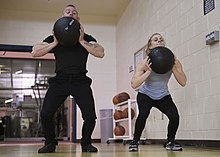
Ballistic training, also known as compensatory acceleration training,[1][2] uses exercises which accelerate a force through the entire range of motion.[1][3] It is a form of power training which can involve throwing weights, jumping with weights, or swinging weights in order to increase explosive power.[4] The intention in ballistic exercises is to maximise the acceleration phase of an object's movement and minimise the deceleration phase. For instance, throwing a medicine ball maximises the acceleration of the ball.[5] This can be contrasted with a standard weight training exercise where there would be a pronounced deceleration phase at the end of the repetition i.e. at the end of a bench press exercise the barbell is decelerated and brought to a halt. Similarly, an athlete jumping whilst holding a trap bar maximises the acceleration of the weight through the process of holding it whilst they jump- where as they would decelerate it at the end of a standard trap bar deadlift.[6]
- ^ a b Winwood, Paul W (2011). "The Strength and Conditioning Practices of Strongman Competitors". Journal of Strength and Conditioning Research. 25 (11): 3118–3128. doi:10.1519/JSC.0b013e318212daea.
- ^ Swinton, Paul A (2009). "Contemporary Training Practices in Elite British Powerlifters: Survey Results From an International Competition". Journal of Strength and Conditioning Research. 23 (2): 380–384. doi:10.1519/JSC.0b013e31819424bd. hdl:10059/907.
- ^ Jay Hoffman (2014). Physiological Aspects of Sport Training and Performance. Human Kinetics. p. 151. ISBN 9781492583660.
- ^ Tudor Bompa & Carlo A. Buzzichelli (2015). Periodization Training for Sport (3 ed.). Champaign: Human Kinetics. pp. 278–279. ISBN 978-1-4504-6943-2.
- ^ Daniel Guzman & Megan Young (2023). Strength Training for Soccer. Champaign: Human Kinetics. p. 187. ISBN 978-1-4925-9834-3.
- ^ Fleck, Steven J. & Kraemer, William J., 'Ballistic Training' in Designing Resistance Training Programmes, Human Kinetics:Leeds, 2013, p.280